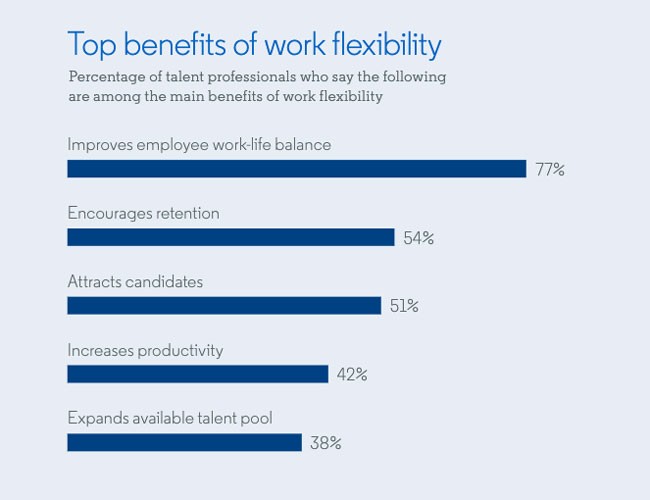“I practice work flexibility every single day,” says Anne Donovan, the U.S. People Experience Leader at PwC, who is enjoying the fresh air in her own backyard while on a call with us.
She’s able to do this because PwC has spent the last decade building a culture of “everyday flexibility” that allows employees to work where and when they choose.
When her two daughters were younger, this flexibility was perfect for Anne and allowed her to spend more time with them. Now they are grown and off to college, but she still prefers not to work in the office and has the ability to adjust her schedule as needed.
And she’s not alone — work flexibility has become increasingly important in the past four years with a 24% increase in the number of people who say flexible work arrangements are a very important factor when considering a new job, according to our Global Talent Trends 2019 report. In fact, PwC’s “everyday flexibility” policy has helped it make Fortune’s 100 Best Companies to Work For list 15 years in a row.
But the culture of flexibility didn’t materialize overnight.
“I like to say that when we started, we couldn’t spell the word flexibility,” Anne jokes. “We really did start from scratch. I won’t profess to say we’ve got it solved, but I think we’ve come a long, long way, and I’m proud that we started early.”
Here are Anne’s tips for making flexibility work for everyone — and how you can nurture a flexible culture like PwC’s in order to boost your employer brand, increase employee retention and productivity, and more.
1. Find out what employees really want and continue to evolve your policies
PwC’s move toward a culture of flexibility began around the time millennials entered the workforce.
“We were studying our generations at PwC,” Anne recalls. “What we found was that one of the top three things our millennials wanted at work was flexibility, so it was an easy business case for us. And as we started rolling it out, all of our generations said, ‘This is fantastic.’”
Since then, flexibility has only grown more important to candidates. And companies are responding: data from LinkedIn’s Global Talent Trends 2019 report shows that there has been a 78% increase in job posts on LinkedIn that mention work flexibility since 2016.
For many millennials, more flexibility correlates with greater loyalty to the company — with the majority even willing to take a pay cut to find flexibility elsewhere.
If you’re not sure whether employees will embrace flexible work options, find out what they really want and ask how they see it working. Maybe they want certain things and not others and that’s okay — flexibility is, by nature, optional. And by understanding what your employees really want, you can create a policy that is unique to your company.
2. Offer the same degree of flexibility to everyone — and let them be flexible about how they use it
Flexible work options can be especially valuable to some employees, like parents re-entering the workforce. But everyone can benefit from them, regardless of their age or circumstances.
PwC’s flexibility policies are predicated on the belief that everyone’s reason for wanting them are equally valid. That’s why the company has been careful not to highlight any particular segment of the workforce in its messaging.
“We did not gear our program toward any specific group, and we did not find that any specific group wants it more than others,” says Anne. “Everyone wants and deserves flexibility. It’s no less important to want to participate in a softball league or to be a yoga instructor than it is to want to get home and spend the evening with your kids. Those are equal in our minds.”
Giving everyone the same options is vital if you want flexibility to become a core part of your culture. Otherwise, it can feel too exclusive, making some employees feel left out. But it’s also important to be flexible about what flexibility means. Everyone’s circumstances are a little different, so people will embrace it in different ways.
At PwC, there are no hard-and-fast rules. Employees are empowered to make flexibility work for themselves and for their teams however they see fit.
“We called our program Flexibility² and that’s our signal to remind ourselves that it has to work for both the company and the person,” Anne says. “Each individual has to work it out with their boss, and we laid that out from the beginning.”
After some trial and error, PwC came up with some simple programs to give their employees a sense of what flexibility means and how they can use it in their everyday work life:

They also made it clear that employees don’t need to be at their desk and in the office working a typical 9 to 5, Monday through Friday. Remote and telecommunicating options are widely encouraged:

Lastly, it’s okay to have loose policies in place, like letting your coworkers and managers know when you’re taking the afternoon off, rather than just disappearing. But being too rigid about flexibility makes it difficult for employees to adopt and embrace the new mindset. Clearly communicate the boundaries, but give people room to breathe if you expect a policy to catch on and stick.
3. Ensure trust is baked in
Some companies are wary about offering flexible work options because they think productivity will suffer. But PwC says it trusts its employees no matter how flexible their schedule is or how long they’ve been with the company. After all, the firm hired them for a reason.
“We don’t have the mantra that you have to be here a certain amount of time before you have flexibility or that you have to earn it,” Anne says. “You have to trust your employees from the day they walk in the door. That’s why you hired them. And you shouldn’t have to see them to trust them — if you do, that’s another issue.”
At PwC, trust means more than simply letting people work without the company peering over their shoulder. By placing its trust in all its employees, PwC also trusts that they’ll return the favor and be flexible when the company needs it.
Since business needs can fluctuate as quickly as an employee’s own circumstances, creating a culture that emphasizes mutual flexibility can be beneficial to both sides. That way, working different hours when the company needs it feels less like an unwelcome obligation and more like loyalty to an organization that invests in its employees.
4. Talk about flexibility until it sticks — and make sure leaders are talking about it too
Today, flexibility isn’t just a policy at PwC. It’s a major part of the company culture that employees live and breathe every day.
Getting to that point takes time, effort, and a little trial and error. Something you can start doing right away is talk about flexibility as much as possible. This will help the idea take root in employees’ minds, allowing it to grow into something more than just words on paper.
“We started talking about it, using the terminology, and getting our leadership talking about it,” Anne says. “In an organization this big, it helps to start infusing the culture with the words, to hear leadership use the terminology, and start to get everybody comfortable with the thing we’re going to do.”
Getting leadership actively engaged in the process was a major step for PwC. Anne recalls that in the past, cultural change had typically come from the top down, so it was important for employees at all levels to be involved.
“We gave permission at the top to allow for flexibility, and then we went to the bottom and said this is your right, this is what you’re allowed to have — now go get it,” she says. “It was exciting to do it this way because what we said to our people was, now it’s on you to go make this happen.”
Get everyone talking about flexibility and participating in the program. Make sure that managers lead by example to help other employees feel comfortable working flexible hours themselves. It may feel strange at first because real and lasting cultural change takes time. Like anything else, if you do it enough, it will soon become second nature.
True flexibility can be good for employees and good for the company
According to our report, flexibility can improve retention, morale, and work-life balance, which in turn can make employees happier and healthier.
 And PwC is proof of this. Flexibility has had a significant impact on engagement — and it’s become a proud feather in the recruiting team’s cap.
And PwC is proof of this. Flexibility has had a significant impact on engagement — and it’s become a proud feather in the recruiting team’s cap.
“We’re very proud of it and talk about it in our recruiting process,” Anne says. “Our people have appreciated it so much and have been so excited about this new way of working. It’s certainly helped engagement.”
As demand for flexibility increases, offering flexible work benefits will help set your company apart from the competition. And if you don’t offer them, you risk being left behind.
“Your people want flexibility. It’s on their minds,” says Anne. “I believe companies are going to have to jump on this train sooner or later, so you might as well dig in! We have not found a downside.”









